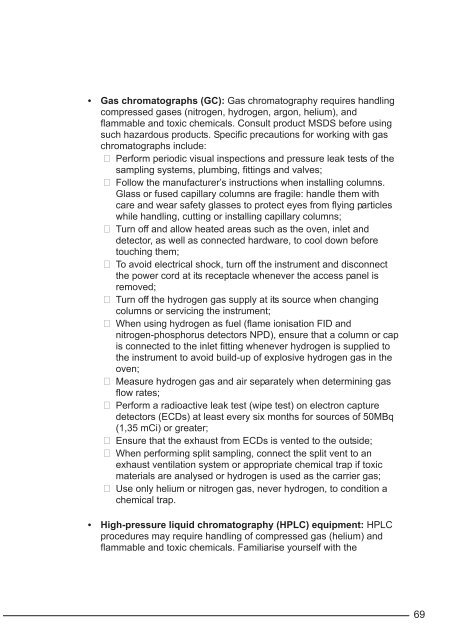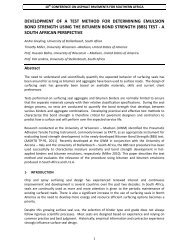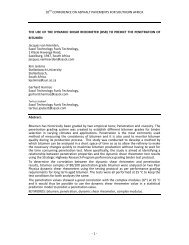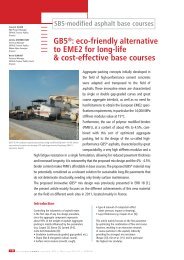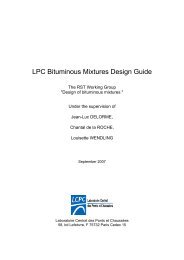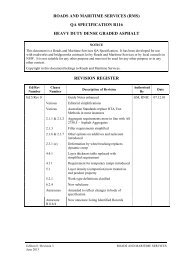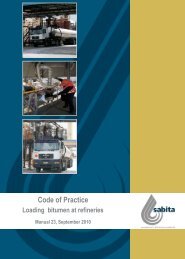Guide to the safe handling of solvents in a bituminous ... - Aapaq.org
Guide to the safe handling of solvents in a bituminous ... - Aapaq.org
Guide to the safe handling of solvents in a bituminous ... - Aapaq.org
- No tags were found...
You also want an ePaper? Increase the reach of your titles
YUMPU automatically turns print PDFs into web optimized ePapers that Google loves.
• Gas chroma<strong>to</strong>graphs (GC): Gas chroma<strong>to</strong>graphy requires <strong>handl<strong>in</strong>g</strong>compressed gases (nitrogen, hydrogen, argon, helium), andflammable and <strong>to</strong>xic chemicals. Consult product MSDS before us<strong>in</strong>gsuch hazardous products. Specific precautions for work<strong>in</strong>g with gaschroma<strong>to</strong>graphs <strong>in</strong>clude: Perform periodic visual <strong>in</strong>spections and pressure leak tests <strong>of</strong> <strong>the</strong>sampl<strong>in</strong>g systems, plumb<strong>in</strong>g, fitt<strong>in</strong>gs and valves; Follow <strong>the</strong> manufacturer’s <strong>in</strong>structions when <strong>in</strong>stall<strong>in</strong>g columns.Glass or fused capillary columns are fragile: handle <strong>the</strong>m withcare and wear <strong>safe</strong>ty glasses <strong>to</strong> protect eyes from fly<strong>in</strong>g particleswhile <strong>handl<strong>in</strong>g</strong>, cutt<strong>in</strong>g or <strong>in</strong>stall<strong>in</strong>g capillary columns; Turn <strong>of</strong>f and allow heated areas such as <strong>the</strong> oven, <strong>in</strong>let anddetec<strong>to</strong>r, as well as connected hardware, <strong>to</strong> cool down before<strong>to</strong>uch<strong>in</strong>g <strong>the</strong>m; To avoid electrical shock, turn <strong>of</strong>f <strong>the</strong> <strong>in</strong>strument and disconnect<strong>the</strong> power cord at its receptacle whenever <strong>the</strong> access panel isremoved; Turn <strong>of</strong>f <strong>the</strong> hydrogen gas supply at its source when chang<strong>in</strong>gcolumns or servic<strong>in</strong>g <strong>the</strong> <strong>in</strong>strument; When us<strong>in</strong>g hydrogen as fuel (flame ionisation FID andnitrogen-phosphorus detec<strong>to</strong>rs NPD), ensure that a column or capis connected <strong>to</strong> <strong>the</strong> <strong>in</strong>let fitt<strong>in</strong>g whenever hydrogen is supplied <strong>to</strong><strong>the</strong> <strong>in</strong>strument <strong>to</strong> avoid build-up <strong>of</strong> explosive hydrogen gas <strong>in</strong> <strong>the</strong>oven; Measure hydrogen gas and air separately when determ<strong>in</strong><strong>in</strong>g gasflow rates; Perform a radioactive leak test (wipe test) on electron capturedetec<strong>to</strong>rs (ECDs) at least every six months for sources <strong>of</strong> 50MBq(1,35 mCi) or greater; Ensure that <strong>the</strong> exhaust from ECDs is vented <strong>to</strong> <strong>the</strong> outside; When perform<strong>in</strong>g split sampl<strong>in</strong>g, connect <strong>the</strong> split vent <strong>to</strong> anexhaust ventilation system or appropriate chemical trap if <strong>to</strong>xicmaterials are analysed or hydrogen is used as <strong>the</strong> carrier gas; Use only helium or nitrogen gas, never hydrogen, <strong>to</strong> condition achemical trap.• High-pressure liquid chroma<strong>to</strong>graphy (HPLC) equipment: HPLCprocedures may require <strong>handl<strong>in</strong>g</strong> <strong>of</strong> compressed gas (helium) andflammable and <strong>to</strong>xic chemicals. Familiarise yourself with <strong>the</strong>69


